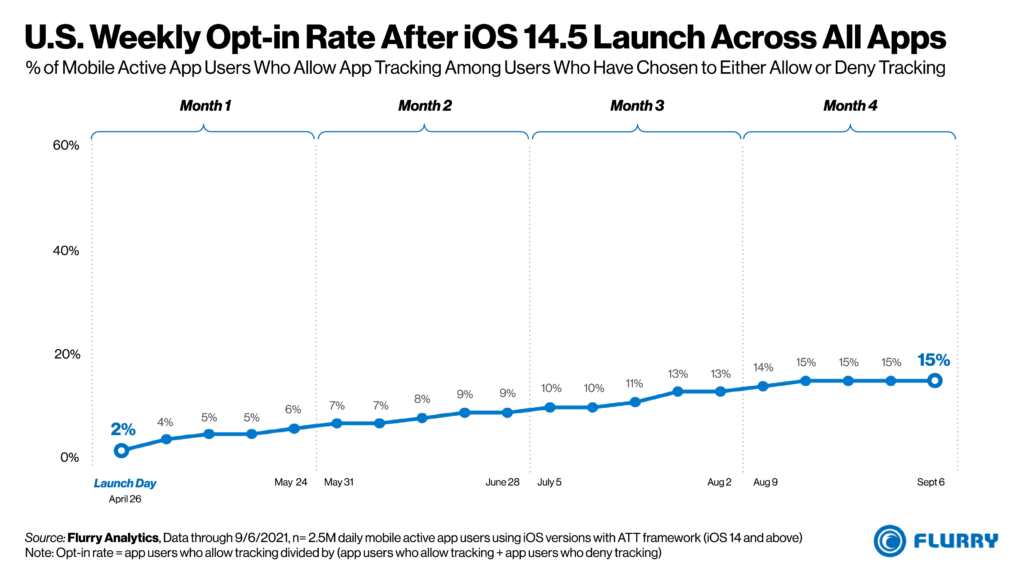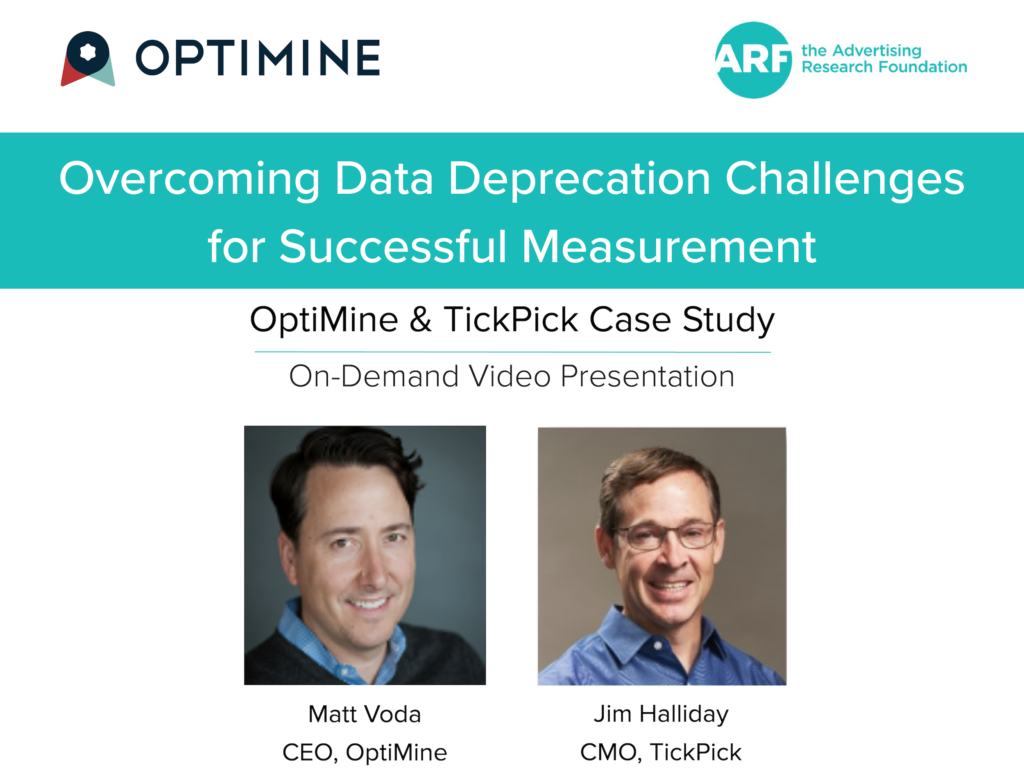Your Marketing Measurement is Going Dark
09/28/2021
Imagine you are standing in front of a large wall-sized stadium scoreboard during a critical game. Now imagine that one by one, each LED light on the scoreboard turns off. For some time, your mind can still fill in the gaps to see the score. But at some point, enough LED lights will turn off and you can no longer tell the difference between a 5 and an 8, or if your favorite team has 1 point or 10. The scoreboard going dark is in many ways your tracking-based marketing measurement— the pixels are going dark and the performance picture is becoming increasingly difficult to see. And at some point, tracking will no longer be complete or accurate enough for you to keep score of your marketing investments.

What is Happening?
Why is the scoreboard going dark? In April, Apple released iOS 14.5 and required that app developers and apps request users’ permission to track them. As part of Apple’s App Tracking Transparency or “ATT”, Apple only makes the IDFA— or ID for Advertisers— available to the app when users give permission for tracking using this unique identifier. Some marketers may have mistakenly concluded that this was only an “app issue” and that if they were not advertising to users to install an app that their brand would be unaffected. In September of this year, Apple rolled our iOS 15, which included a new email privacy feature called “Mail Privacy Protection” or MPP. MPP allows Apple users to prevent the tracking of email opens. When looking at the numbers, it is easy to see why Apple’s privacy changes are such a big deal:
- In March, 2021, Apple had 113 million iPhone users in the US, accounting for 47% of all smartphone users in the US1
- Apple’s iOS operating system has 60% market share in the US1
- And over time, mobile has grown to be a larger and larger share of total internet use, and in North America, accounts for over 50% of traffic.2
- Apple devices account for approximately 52% of all email opens, according to Litmus.

So, just how many users are opting out of tracking anyway?
As it turns out, most of them. After Apple’s changes rolled out initially, approximately 96% of U.S. users & 88% of worldwide users opted out.3 Now as the privacy changes have hit more users, opt-out rates have stabilized with approximately 85% of U.S. users opting out.4 With each user opting out of tracking, another pixel goes dark from a marketing measurement perspective, and the picture has grown a lot dimmer over the last few months.

How is the Tracking Data Loss Affecting the Market?
There are 4 main marketing measurement impacts related to Apple’s changes:
(1) Pixel or click-based tracking is no longer accurate. If you or your brand has relied on last-click tracking for marketing measurement, or even fractional attribution based on touches and clicks, Apple’s changes have put a serious dent into this kind of tracking. In the mobile app space, Apple’s IDFA changes are estimated to have triggered a 15% to 20% drop in ad revenues5 and while this isn’t performance measurement related, it does point out the significance of the tracking impact— which does reduce the ability to track and measure ad performance.
(2) More heavily mobile ad channels and partners such as Facebook, or other more mobile-centric advertising campaigns are also suffering significant reductions in tracking-based performance measurement. Ars technica reports that before the new iOS feature was rolled out, media buyers reported that Facebook could capture as much as 95% of sales made on their clients sites. Now, many media buyers are reporting that Facebook is only capturing 50% of sales. One buyer reported that, with one client, just 3% of sales are showing up in Facebook’s ad manager.6
Also, Facebook has recently announced that it’s under-reporting the results of its advertising business on Apple iOS devices by roughly 15%.7 This announcement is notable for a few reasons:
- The under-counting by 15% is probably an under-count itself as Facebook seeks to put this issue in the best light possible
- For many brands, the issue may be much larger than 15%, especially if their ads are more highly targeted
- And even if a brand’s overall Facebook performance is off by 15%, some campaigns may be much worse than this with the problem being that there’s no way to know when using tracking-based measurement.

(3) Organic search has magically gotten better since April. What a brand used to be able to track and attribute back to a specific campaign is likely to now show up in organic search. The problem is twofold: all of the organic traffic wasn’t really “organic” even before Apple’s change— much of it could have been attributed to other campaign sources with more sophisticated models and measurement approaches; and it is now harder to know the real ROI of your investments in SEO.
(4) A/B Testing will become significantly more difficult for digital ads and campaigns. To run a successful A/B test, the integrity of the test and control groups needs to be maintained flawlessly. This is much harder to do when you can no longer control the test and control groups on any iOS device. And because conversion rates are generally pretty low, even a small number of conversions that leak from one group to the other will throw off the accuracy of the test. Advertisers are being forced to use more geographic-based A/B testing to try to overcome these new issues, but geo-based tests can be more difficult, expensive and slower to run.
Want to see how one of OptiMine’s clients— TickPick— used OptiMine to overcome Apple’s measurement challenges? Watch the Advertising Research Foundation’s “Measurement Challenges” Showcase to see how TickPick’s CMO Jim Halliday worked to ensure their business could navigate around these challenges successfully:
Google to Follow in Apple’s Footsteps

With a major part of the digital advertising ecosystem gone dark with Apple’s changes, these represent a mere warm- up act for the next major change to hit: Google Topics. These changes to Chrome (starting in 2023) will permanently kill the cookie and introduce their cohort-based targeting and measurement approach.
With Google Topics, advertisers will no longer have the ability to target nor track individual users. And while Google has promised to provide attribution of advertising performance, this will present several major issues for marketers and their approaches to attribution:
(1) Fox in the Hen House: marketers will rely on Google to tell them how their paid advertising on Google performs. Such conflicts of interest raise real issues around accuracy, transparency and governance.
(2) Ads in a Vacuum: Google’s own attribution tools will only speak to performance of a Google ad, and will be silent on any non-Google advertising contributions to the ad’s performance. The net of this is that:
- Google will overstate the value and performance of its own ads
- Google will not be able to measure how your non-Google ads give a lift to your Google ads. So if you are spending money in channels such as TV, print, radio, direct mail, e-mail, video, social, and OOH- all of which are certainly driving performance lift in your Google campaigns, this cross-channel lift will be missed completely.
- Likewise, your Google ads are likely driving a lift in performance in your other marketing channels and Google won’t be able to tell you anything about that either.
(3) Chrome is Only Part of the Market: even though Google Chrome has the largest market share in the US at 48%8, all of the remaining browsers (Apple Safari, Microsoft Edge, Firefox, Opera, Brave, etc.) represent over 50% of the market and all have indicated that they will not support Topics. Further, Safari has 36% of the market, and if their IDFA privacy changes are any indication, they will likely pursue additional privacy protections, tracking restrictions and user tools thereby further darkening the browser-based tracking picture.
How to Future-Proof your Marketing Measurement?
Don’t wait for the scoreboard to disappear. The time is NOW to act. If you or your brand is still using tracking to measure the performance of your digital advertising, there is no question that the picture will become too difficult to read over time. In the meantime, a brand will make unforced errors, spend decision mistakes and damage their businesses needlessly by sticking with tracking over time.

It is possible to future-proof your marketing measurement and the good news is that there are proven ways to measure marketing performance that do not rely on tracking, consumer and device identity data, nor PII. Read OptiMine’s 4 Ways to Future-Proof Your Marketing Measurement guide to start your planning now.

Sources:
- https://www.statista.com/statistics/236550/percentage-of-us-population-that-own-a-iphone-smartphone
- https://www.statista.com/statistics/306528/share-of-mobile-internet-traffic-in-global-regions/
- https://mashable.com/article/ios-14-5-users-opt-out-of-ad-tracking
- https://www.flurry.com/blog/ios-14-5-opt-in-rate-idfa-app-tracking-transparency-weekly/
- https://venturebeat.com/2021/07/13/brian-bowman-apples-idfa-change-has-triggered-15-to-20-revenue-drops-for-ios-developers/
- https://arstechnica.com/tech-policy/2021/07/facebook-advertisers-are-panicking-after-ios-cuts-off-key-tracking-data/
- https://www.facebook.com/business/news/navigating-change-and-improving-performance-and-measurement
- https://gs.statcounter.com/browser-market-share/all/united-states-of-america







